2003 FORD F150 automatic transmission
[x] Cancel search: automatic transmissionPage 151 of 280

4L (4WD Low)–Uses extra gearing to provide maximum power to all
four wheels at reduced speeds. Intended only for off-road applications
such as deep sand, steep grades or pulling heavy objects. 4L (4WD Low)
will not engage while the vehicle is moving; this is normal and should be
no reason for concern. Refer toShifting to/from 4L (4WD Low)for
proper operation.
Shifting between 2H (2WD high) and 4H (4WD high)
•Move the transfer case lever to 4H (4WD High) at a stop or any
forward speed up to 88 km/h (55 mph).
Note:Do not perform this operation at speeds above 72 km/h (45 mph)
if the outside temperature is below 0°C (32°F).
Note:Do not perform this operation if the rear wheels are slipping.
Shifting to/from 4L (4WD Low)
1. Bring the vehicle to a complete stop.
2. Depress the brake.
3. On vehicles equipped with an automatic transmission, place the
transmission in N (Neutral); on vehicles equipped with a manual
transmission, depress the clutch.
4. Move the transfer case lever through N (Neutral) directly to the
desired position. The LOW RANGE indicator will illuminate once the
transfer case has engaged.
•If the transfer casedoes notengage, repeat steps 1 through 4.
Using the N (Neutral) position
The transfer case N (Neutral) position overrides the transmission
and puts the vehicle in neutral regardless of transmission
gearshift lever position. The vehicle can move forward or
backward.
This position should only be used when towing the vehicle.
Do not leave the vehicle unattended with the transfer case in the
N (Neutral) position. Always set the parking brake fully and turn
off the ignition when leaving the vehicle.
Driving
151
Page 152 of 280
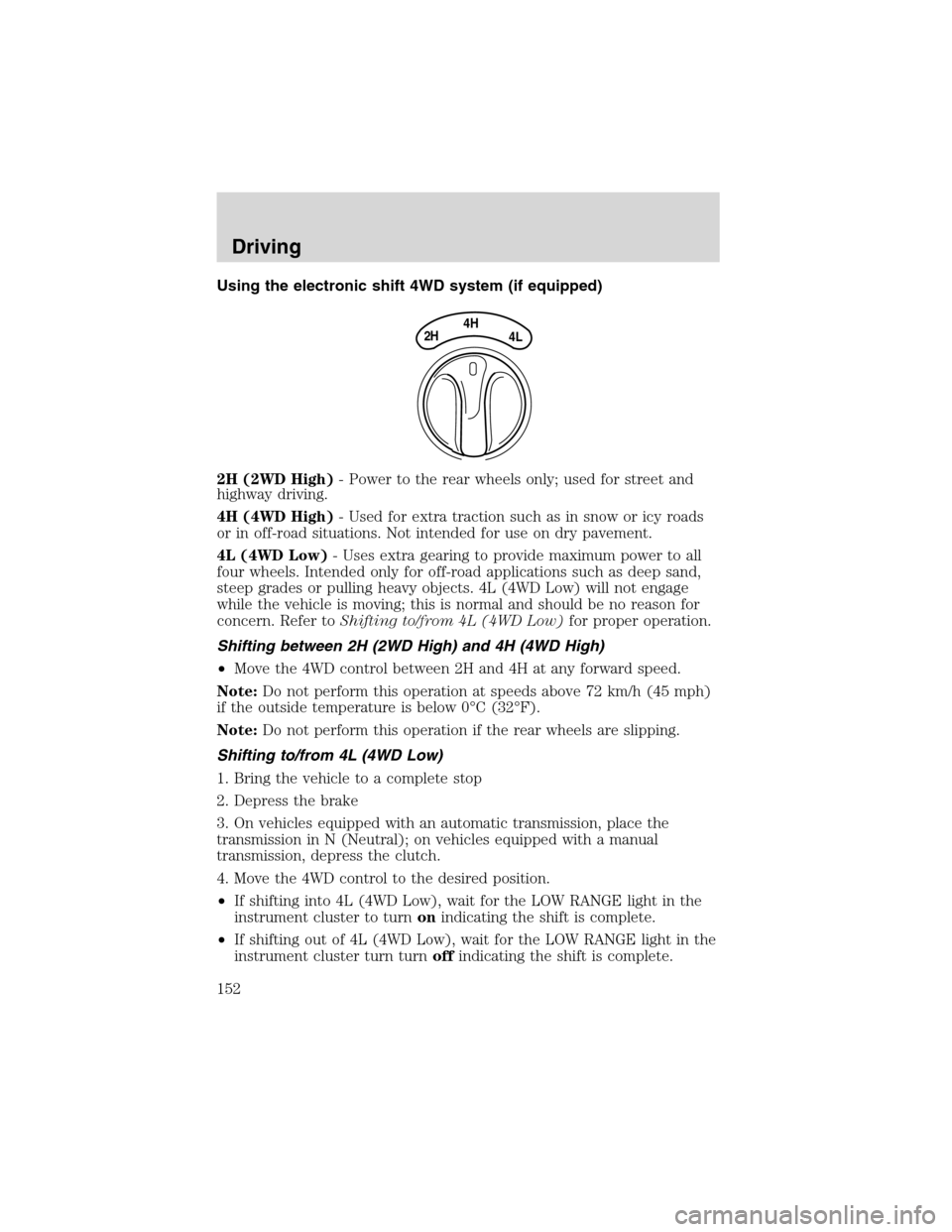
Using the electronic shift 4WD system (if equipped)
2H (2WD High)- Power to the rear wheels only; used for street and
highway driving.
4H (4WD High)- Used for extra traction such as in snow or icy roads
or in off-road situations. Not intended for use on dry pavement.
4L (4WD Low)- Uses extra gearing to provide maximum power to all
four wheels. Intended only for off-road applications such as deep sand,
steep grades or pulling heavy objects. 4L (4WD Low) will not engage
while the vehicle is moving; this is normal and should be no reason for
concern. Refer toShifting to/from 4L (4WD Low)for proper operation.
Shifting between 2H (2WD High) and 4H (4WD High)
•Move the 4WD control between 2H and 4H at any forward speed.
Note:Do not perform this operation at speeds above 72 km/h (45 mph)
if the outside temperature is below 0°C (32°F).
Note:Do not perform this operation if the rear wheels are slipping.
Shifting to/from 4L (4WD Low)
1. Bring the vehicle to a complete stop
2. Depress the brake
3. On vehicles equipped with an automatic transmission, place the
transmission in N (Neutral); on vehicles equipped with a manual
transmission, depress the clutch.
4. Move the 4WD control to the desired position.
•If shifting into 4L (4WD Low), wait for the LOW RANGE light in the
instrument cluster to turnonindicating the shift is complete.
•If shifting out of 4L (4WD Low), wait for the LOW RANGE light in the
instrument cluster turn turnoffindicating the shift is complete.
4H
2H4L
Driving
152
Page 155 of 280

turn the steering wheel only as rapidly and as far as required to avoid
the emergency. Excessive steering will result in less vehicle control,
not more. Additionally, smooth variations of the accelerator and/or
brake pedal pressure should be utilized if changes in vehicle speed are
called for. Avoid abrupt steering, acceleration or braking which could
result in an increased risk of loss of vehicle control, vehicle rollover
and/or personal injury. Use all available road surface to return the
vehicle to a safe direction of travel.
•In the event of an emergency stop, avoid skidding the tires and do not
attempt any sharp steering wheel movements.
Vehicles with a higher center of gravity such as utility and
four-wheel drive vehicles handle differently than vehicles with a
lower center of gravity. Utility and four-wheel drive vehicles arenot
designed for cornering at speeds as high as passenger cars any more
than low-slung sports cars are designed to perform satisfactorily under
off-road conditions. Avoid sharp turns, excessive speed and abrupt
maneuvers in these vehicles. Failure to drive cautiously could result in
an increased risk of loss of vehicle control, vehicle rollover, personal
injury and death.
•If the vehicle goes from one type of surface to another (i.e., from
concrete to gravel) there will be a change in the way the vehicle
responds to a maneuver (steering, acceleration or braking). Again,
avoid these abrupt inputs.
Parking
On some 4WD vehicles, when the transfer case is in the N (Neutral)
position, the engine and transmission are disconnected from the rest of
the driveline. Therefore, the vehicle is free to roll even if the automatic
transmission is in P (Park) or the manual transmission is in gear. Do not
leave the vehicle unattended with the transfer case in the N (Neutral)
position. Always set the parking brake fully and turn off the ignition
when leaving the vehicle.
4WD Systems
4WD (when you select a 4WD mode) uses all four wheels to power the
vehicle. This increases traction, enabling you to drive over terrain and
road conditions that a conventional two-wheel drive vehicle cannot.
Driving
155
Page 164 of 280

Towing trailers beyond the maximum recommended gross trailer
weight exceeds the limit of the vehicle and could result in
engine damage, transmission damage, structural damage, loss of vehicle
control, vehicle rollover and personal injury.
Engine Rear axle ratio Maximum
GCWR-kg
(lbs.)Maximum
trailer
weight-kg
(lbs.)
Regular Cab 4x2 w/automatic transmission
4.2L 3.31 4077 (9000) 2132 (4700)
4.2L 3.55 4530 (10000) 2585 (5700)
4.6L 3.08 4530 (10000) 907 (2000)
4.6L 3.31 4763 (10500) 2812 (6200)
4.6L 3.55 5209 (11500) 3261 (7200)
5.4L 3.31 5443 (12000) 3447 (7600)
5.4L 3.55 5897 (13000) 3900 (8600)
5.4L 3.73 6124 (13500) 3992 (8800)
5.4L 4.10 6803 (15000) 3991 (8800)
SuperCab/Super Crew 4x2 w/automatic transmission
4.2L 3.55 4530 (10000) 2495 (5500)
4.6L 3.08 4530 (10000) 907 (2000)
4.6L 3.31 4763 (10500) 2676 (5900)
4.6L 3.55 5216 (11500) 3130 (6900)/
2994 (6600)
5.4L 3.31 5443 (12000) 3311 (7300)
5.4L 3.55 5897 (13000) 3765 (8300)/
3628 (8000)
5.4L 3.73 6124 (13500) 3900 (8600)
5.4L 4.10 6803 (15000) 3900 (8600)
Driving
164
Page 165 of 280
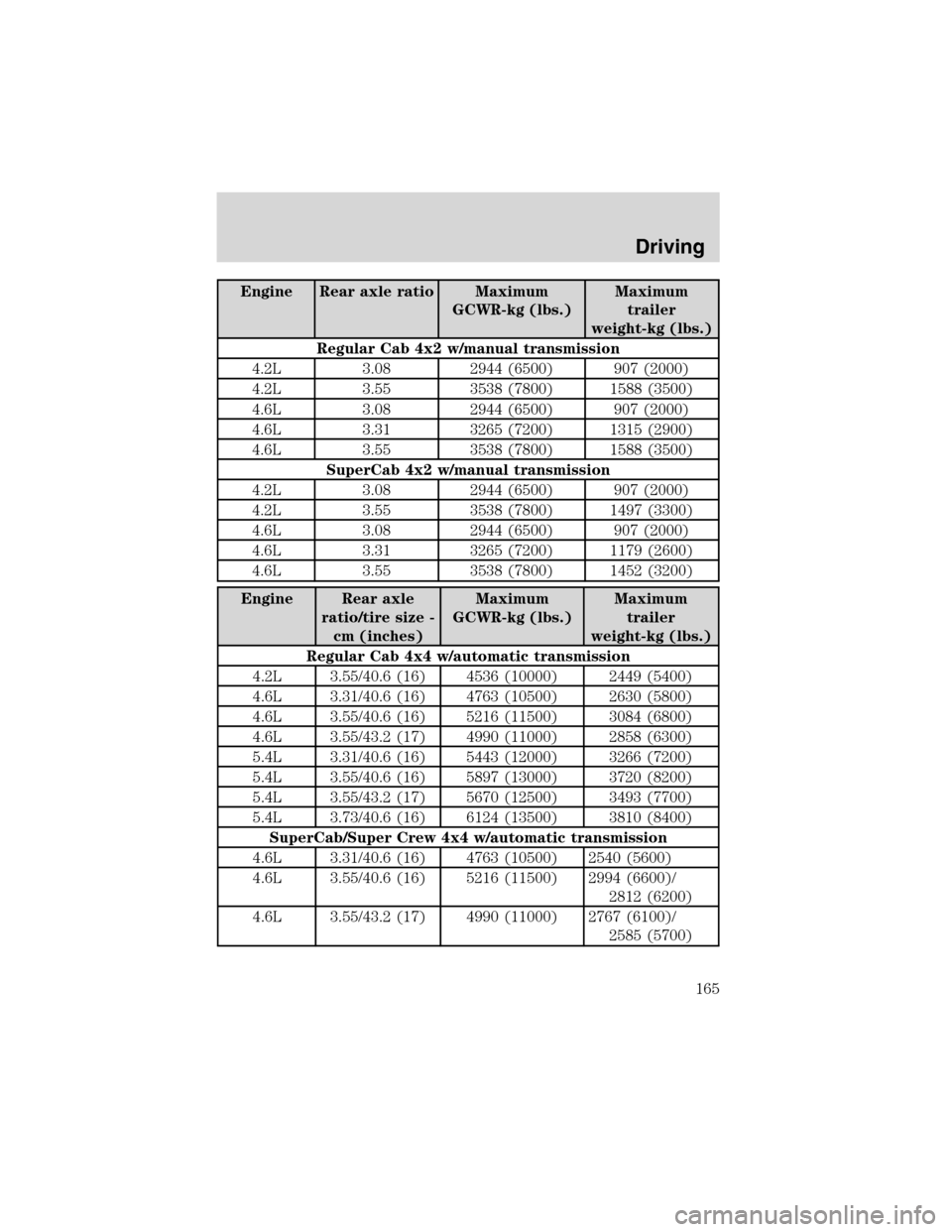
Engine Rear axle ratio Maximum
GCWR-kg (lbs.)Maximum
trailer
weight-kg (lbs.)
Regular Cab 4x2 w/manual transmission
4.2L 3.08 2944 (6500) 907 (2000)
4.2L 3.55 3538 (7800) 1588 (3500)
4.6L 3.08 2944 (6500) 907 (2000)
4.6L 3.31 3265 (7200) 1315 (2900)
4.6L 3.55 3538 (7800) 1588 (3500)
SuperCab 4x2 w/manual transmission
4.2L 3.08 2944 (6500) 907 (2000)
4.2L 3.55 3538 (7800) 1497 (3300)
4.6L 3.08 2944 (6500) 907 (2000)
4.6L 3.31 3265 (7200) 1179 (2600)
4.6L 3.55 3538 (7800) 1452 (3200)
Engine Rear axle
ratio/tire size -
cm (inches)Maximum
GCWR-kg (lbs.)Maximum
trailer
weight-kg (lbs.)
Regular Cab 4x4 w/automatic transmission
4.2L 3.55/40.6 (16) 4536 (10000) 2449 (5400)
4.6L 3.31/40.6 (16) 4763 (10500) 2630 (5800)
4.6L 3.55/40.6 (16) 5216 (11500) 3084 (6800)
4.6L 3.55/43.2 (17) 4990 (11000) 2858 (6300)
5.4L 3.31/40.6 (16) 5443 (12000) 3266 (7200)
5.4L 3.55/40.6 (16) 5897 (13000) 3720 (8200)
5.4L 3.55/43.2 (17) 5670 (12500) 3493 (7700)
5.4L 3.73/40.6 (16) 6124 (13500) 3810 (8400)
SuperCab/Super Crew 4x4 w/automatic transmission
4.6L 3.31/40.6 (16) 4763 (10500) 2540 (5600)
4.6L 3.55/40.6 (16) 5216 (11500) 2994 (6600)/
2812 (6200)
4.6L 3.55/43.2 (17) 4990 (11000) 2767 (6100)/
2585 (5700)
Driving
165
Page 166 of 280
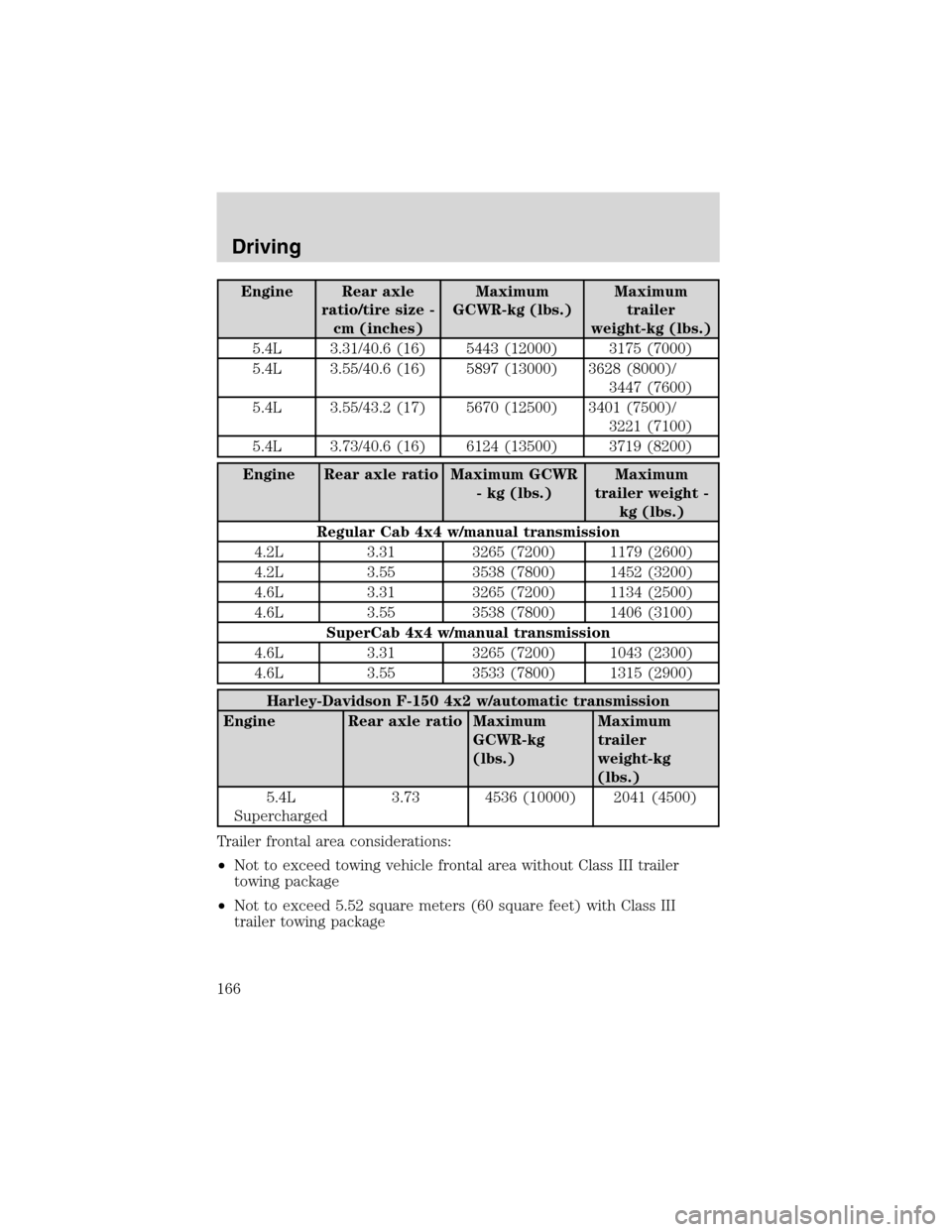
Engine Rear axle
ratio/tire size -
cm (inches)Maximum
GCWR-kg (lbs.)Maximum
trailer
weight-kg (lbs.)
5.4L 3.31/40.6 (16) 5443 (12000) 3175 (7000)
5.4L 3.55/40.6 (16) 5897 (13000) 3628 (8000)/
3447 (7600)
5.4L 3.55/43.2 (17) 5670 (12500) 3401 (7500)/
3221 (7100)
5.4L 3.73/40.6 (16) 6124 (13500) 3719 (8200)
Engine Rear axle ratio Maximum GCWR
- kg (lbs.)Maximum
trailer weight -
kg (lbs.)
Regular Cab 4x4 w/manual transmission
4.2L 3.31 3265 (7200) 1179 (2600)
4.2L 3.55 3538 (7800) 1452 (3200)
4.6L 3.31 3265 (7200) 1134 (2500)
4.6L 3.55 3538 (7800) 1406 (3100)
SuperCab 4x4 w/manual transmission
4.6L 3.31 3265 (7200) 1043 (2300)
4.6L 3.55 3533 (7800) 1315 (2900)
Harley-Davidson F-150 4x2 w/automatic transmission
Engine Rear axle ratio Maximum
GCWR-kg
(lbs.)Maximum
trailer
weight-kg
(lbs.)
5.4L
Supercharged3.73 4536 (10000) 2041 (4500)
Trailer frontal area considerations:
•Not to exceed towing vehicle frontal area without Class III trailer
towing package
•Not to exceed 5.52 square meters (60 square feet) with Class III
trailer towing package
Driving
166
Page 168 of 280
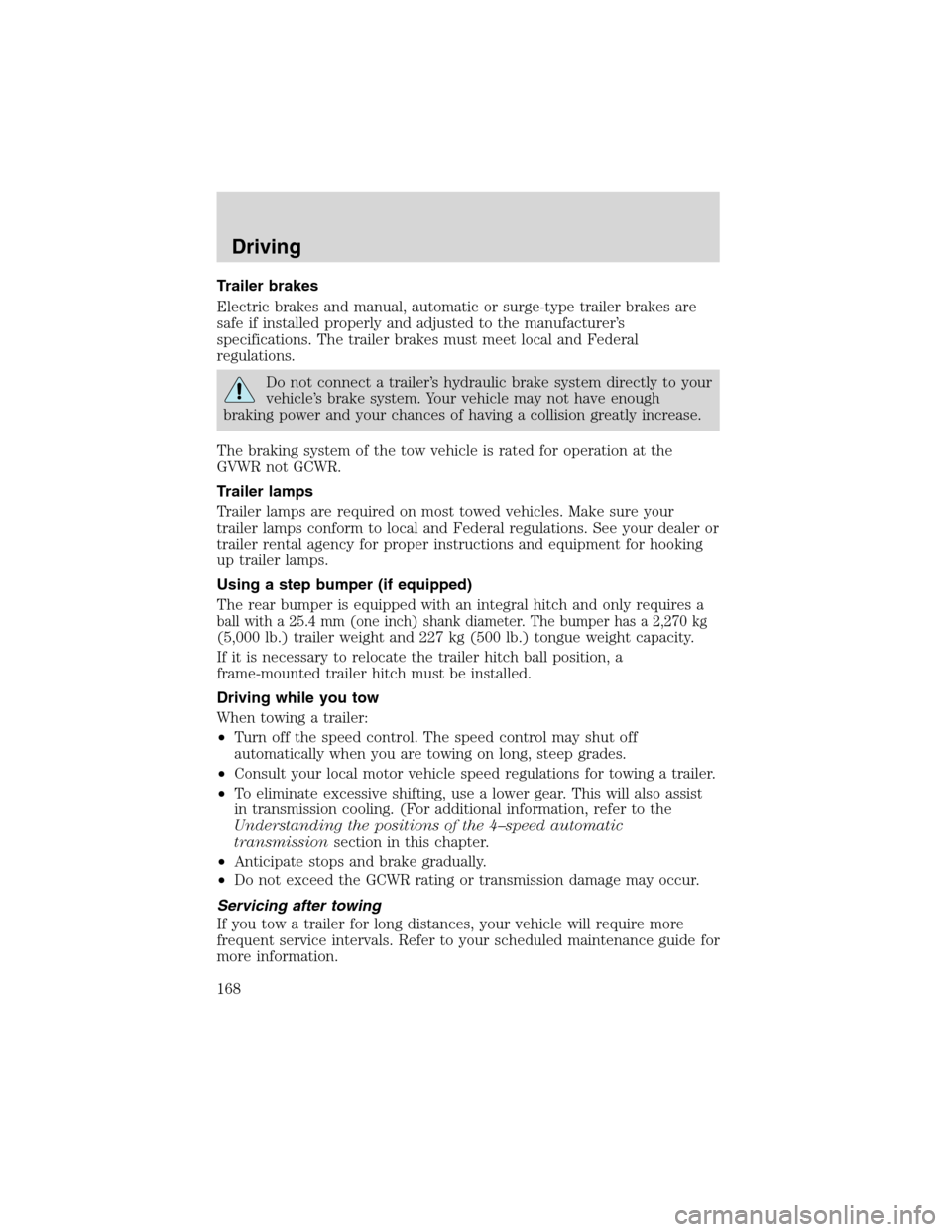
Trailer brakes
Electric brakes and manual, automatic or surge-type trailer brakes are
safe if installed properly and adjusted to the manufacturer’s
specifications. The trailer brakes must meet local and Federal
regulations.
Do not connect a trailer’s hydraulic brake system directly to your
vehicle’s brake system. Your vehicle may not have enough
braking power and your chances of having a collision greatly increase.
The braking system of the tow vehicle is rated for operation at the
GVWR not GCWR.
Trailer lamps
Trailer lamps are required on most towed vehicles. Make sure your
trailer lamps conform to local and Federal regulations. See your dealer or
trailer rental agency for proper instructions and equipment for hooking
up trailer lamps.
Using a step bumper (if equipped)
The rear bumper is equipped with an integral hitch and only requires a
ball with a 25.4 mm (one inch) shank diameter. The bumper has a 2,270 kg
(5,000 lb.) trailer weight and 227 kg (500 lb.) tongue weight capacity.
If it is necessary to relocate the trailer hitch ball position, a
frame-mounted trailer hitch must be installed.
Driving while you tow
When towing a trailer:
•Turn off the speed control. The speed control may shut off
automatically when you are towing on long, steep grades.
•Consult your local motor vehicle speed regulations for towing a trailer.
•To eliminate excessive shifting, use a lower gear. This will also assist
in transmission cooling. (For additional information, refer to the
Understanding the positions of the 4–speed automatic
transmissionsection in this chapter.
•Anticipate stops and brake gradually.
•Do not exceed the GCWR rating or transmission damage may occur.
Servicing after towing
If you tow a trailer for long distances, your vehicle will require more
frequent service intervals. Refer to your scheduled maintenance guide for
more information.
Driving
168
Page 169 of 280
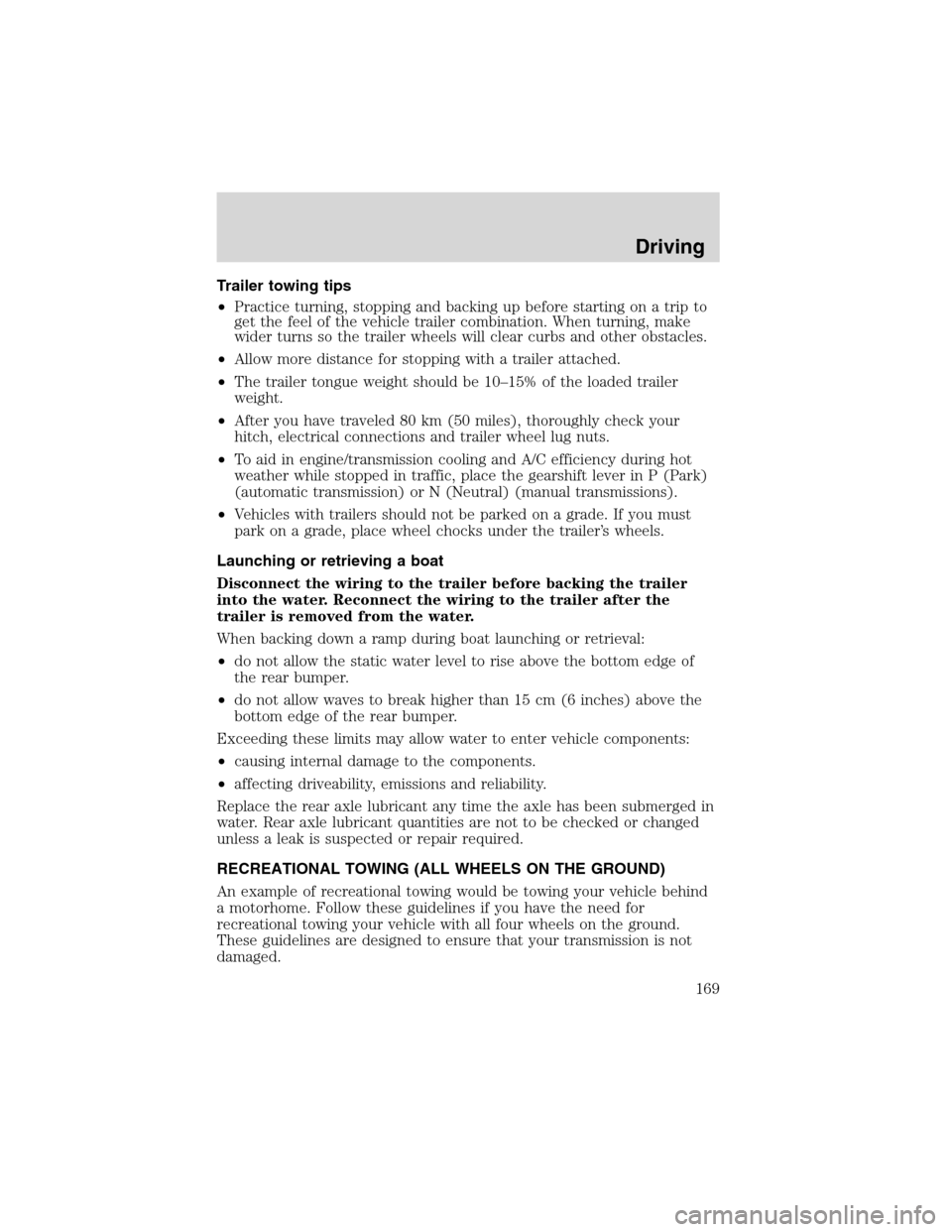
Trailer towing tips
•Practice turning, stopping and backing up before starting on a trip to
get the feel of the vehicle trailer combination. When turning, make
wider turns so the trailer wheels will clear curbs and other obstacles.
•Allow more distance for stopping with a trailer attached.
•The trailer tongue weight should be 10–15% of the loaded trailer
weight.
•After you have traveled 80 km (50 miles), thoroughly check your
hitch, electrical connections and trailer wheel lug nuts.
•To aid in engine/transmission cooling and A/C efficiency during hot
weather while stopped in traffic, place the gearshift lever in P (Park)
(automatic transmission) or N (Neutral) (manual transmissions).
•Vehicles with trailers should not be parked on a grade. If you must
park on a grade, place wheel chocks under the trailer’s wheels.
Launching or retrieving a boat
Disconnect the wiring to the trailer before backing the trailer
into the water. Reconnect the wiring to the trailer after the
trailer is removed from the water.
When backing down a ramp during boat launching or retrieval:
•do not allow the static water level to rise above the bottom edge of
the rear bumper.
•do not allow waves to break higher than 15 cm (6 inches) above the
bottom edge of the rear bumper.
Exceeding these limits may allow water to enter vehicle components:
•causing internal damage to the components.
•affecting driveability, emissions and reliability.
Replace the rear axle lubricant any time the axle has been submerged in
water. Rear axle lubricant quantities are not to be checked or changed
unless a leak is suspected or repair required.
RECREATIONAL TOWING (ALL WHEELS ON THE GROUND)
An example of recreational towing would be towing your vehicle behind
a motorhome. Follow these guidelines if you have the need for
recreational towing your vehicle with all four wheels on the ground.
These guidelines are designed to ensure that your transmission is not
damaged.
Driving
169